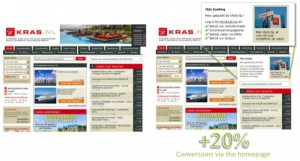“We are more likely to perform an action when we belief the recommended action leads to the desired outcome”
 Response efficacy concerns our belief that a certain action will actually be effective. It is closely related, yet really different from self-efficacy. Where self-efficacy is about how competent we feel we are in displaying the behavior (can we do it?), response efficacy is about whether we think our actions will lead to the desired result (when I do it, will it be effective?).
Response efficacy concerns our belief that a certain action will actually be effective. It is closely related, yet really different from self-efficacy. Where self-efficacy is about how competent we feel we are in displaying the behavior (can we do it?), response efficacy is about whether we think our actions will lead to the desired result (when I do it, will it be effective?).
So we’re often motivated to fulfill certain needs and desires. But we’re reluctant to act upon them when we’re unsure whether our actions will actually be effective.
Response efficacy has been extensively studied within health sciences, mainly within the framework of “Protection Motivation Theory” (see image), and as a useful extension to the “Theory of Planned Behavior”.

Scientific Research example
 Do you ever drive too fast? Is that on purpose or accidentally? Imagine you’re looking at an anti-speeding message on the television. There’s a ‘crash dummy’ driving a car. As he approaches a speed camera, someone overtakes him really fast and gets flashed. This makes the dummy smile”.
Do you ever drive too fast? Is that on purpose or accidentally? Imagine you’re looking at an anti-speeding message on the television. There’s a ‘crash dummy’ driving a car. As he approaches a speed camera, someone overtakes him really fast and gets flashed. This makes the dummy smile”.
What do you think; Would this commercial be effective for you or would you reject the message?
Well, Lewis et. al (2009) found that it depends on your “response efficacy”. If you thought the advertisement included some useful information about how people can reduce their risk of speeding, the message is probably effective for you. But if you thought it doesn’t offer a strategy to reduce speeding, the message will not be effective.
Overall, Lewis et. al.’s study confirmed the importance of emotional and cognitive components of persuasive messages and identified response efficacy as a key cognitive construct influencing the effectiveness of not only fear-based messages but also positive emotion-based messages. Interestingly they found that response efficacy is probably especially an important mediator for positive emotion-based messages (like humor and pride), more than for negative emotions-based massages (like fear).
Online Persuasion tips:
Therefore:
[checklist]
- Response: Find out what different ‘outcomes’ consumers seek, and if you can recognize different segments (ie. Do people calculate mortgage repayments in order to lower their depth, or to be financially better off each month?).
- Message Tailoring: Then specifically focus your message on a visitors specific goal (“Calculate how much money you can save each month”).
- Framing: Bring the specified message, positive or negative (“Calculate how much money you’re losing each month”).
[/checklist]
And most importantly:
[checklist]
- Providing proof: Provide evidence that the recommended behavior leads to the desired results (ie. “93% finds out he’s losing money every month”, or awards , testimonials, …)!
[/checklist]
AB-test:
The Dutch Travel company Kras.nl (part of TUI intl.) switched from catalogues to online a while ago. However, customers still indicate having feelings of uncertainty (“Booking online with virtual travel documents and digital payments, I feel less sure that I indeed have a flight and a hotel”). Hence, they tested the hypothesis that adding information about what one gets when one books, would lead to a higher number of bookings. They ended up selling 20% more vacations!
Further reading on Response efficacy
- Floyd, D. L., Prentice‐Dunn, S., & Rogers, R. W. (2000). A meta‐analysis of research on protection motivation theory. Journal of Applied Social Psychology, 30(2), 407-429.
- Milne, S., Sheeran, P., & Orbell, S. (2000). Prediction and intervention in health‐related behavior: A meta‐analytic review of protection motivation theory. Journal of Applied Social Psychology, 30(1), 106-143.
- Lewis, Ioni M. and Watson, Barry C. and White, Katherine Marie (2009) Response efficacy : the key to minimizing rejection and maximizing acceptance of emotion-based anti-speeding messages. Accident Analysis & Prevention (In press).
- San-Pui Lam (2006). Predicting Intention to Save Water: Theory of Planned Behavior, Response Efficacy, Vulnerability, and Perceived Efficiency of Alternative Solutions. Journal of Applied Social Psychology, 36(11), pages 2803–2824.

